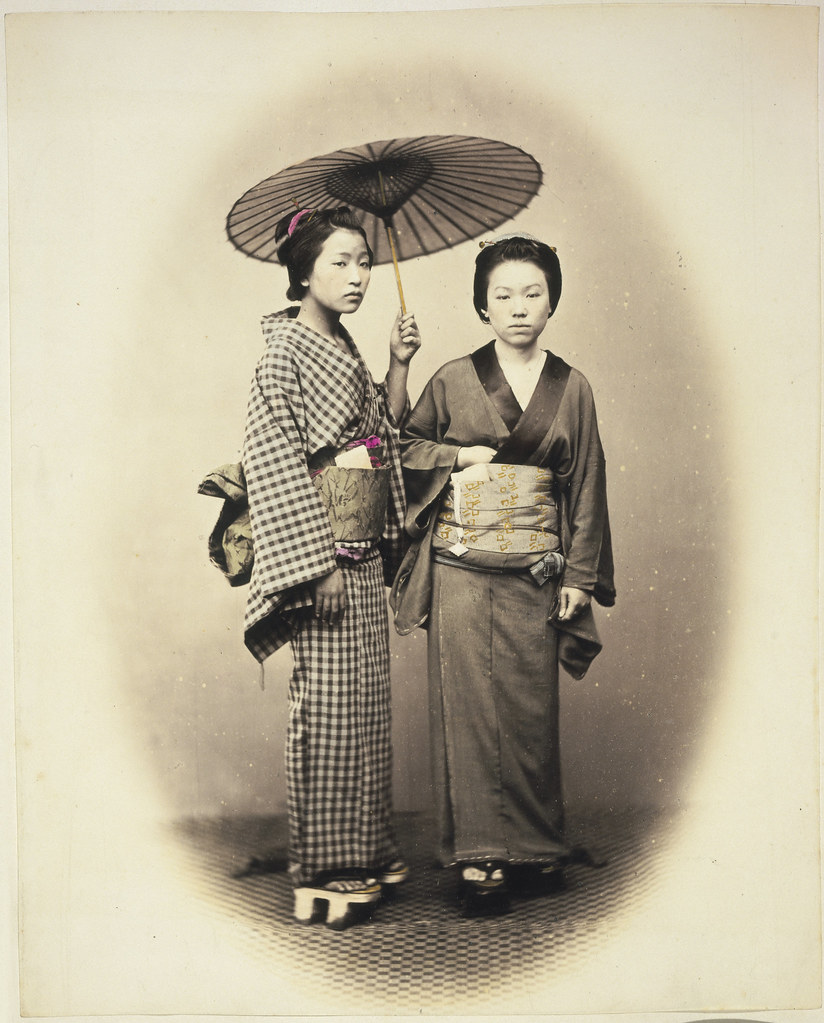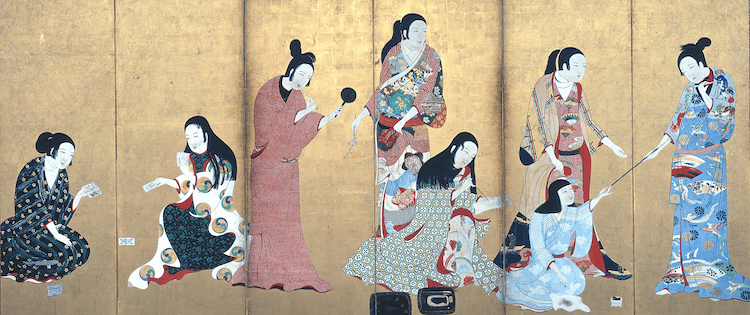
Iwasa Matabei, “Matsura Byobu,” pair of six-fold screens, c. 1650 (Photo: Wikimedia Commons, Public domain)
For generations, Japanese style has been defined by a single garment: the kimono. Historically significant, aesthetically fascinating, and steeped in symbolism, the kimono captures the exquisite elegance of Japanese culture and design, proving that clothing can be much more than meets the eye.
Here, we look at the fascinating evolution of the kimono, tracing its exceptional history from the 8th century through the present and exploring its role in contemporary Japanese culture.
What is a Kimono?
Derived from the words ki (“wear”) and mono (“thing”), the kimono is a traditional Japanese garment. Kimonos come in a range of styles and patterns. They are typically hand-sewn into a “T” shape from four single pieces of fabric called tans and tied with an obi, or belt.
Kimono Symbolism
In addition to their unique aesthetic, kimonos are valued for their symbolism; style, motif, color, and material work together to reveal the individual identity of the wearer.
Style
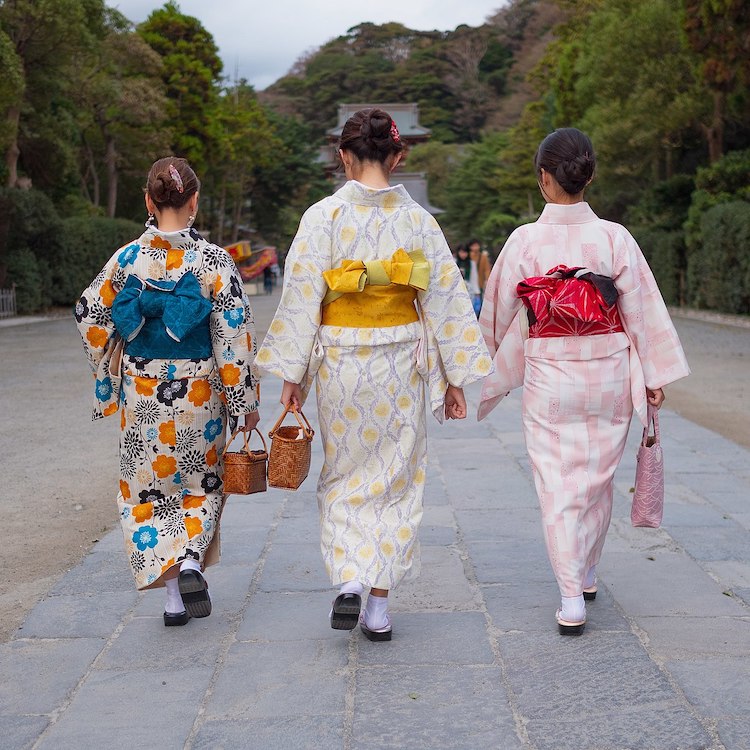
Three women in kimonos, Kanagawa prefecture, Japan (Photo: Benh LIEU SONG via Wikimedia Commons, CC BY-SA 2.0)
Traditional kimonos come in a variety of styles. The type of style worn is dictated by a range of specific criteria, including gender, marital status, and event. For example, an unmarried woman would wear a furisode (“swinging sleeves”) to a formal event, while a male store owner would wear a happi (a type of jacket) to a festival.
Motif
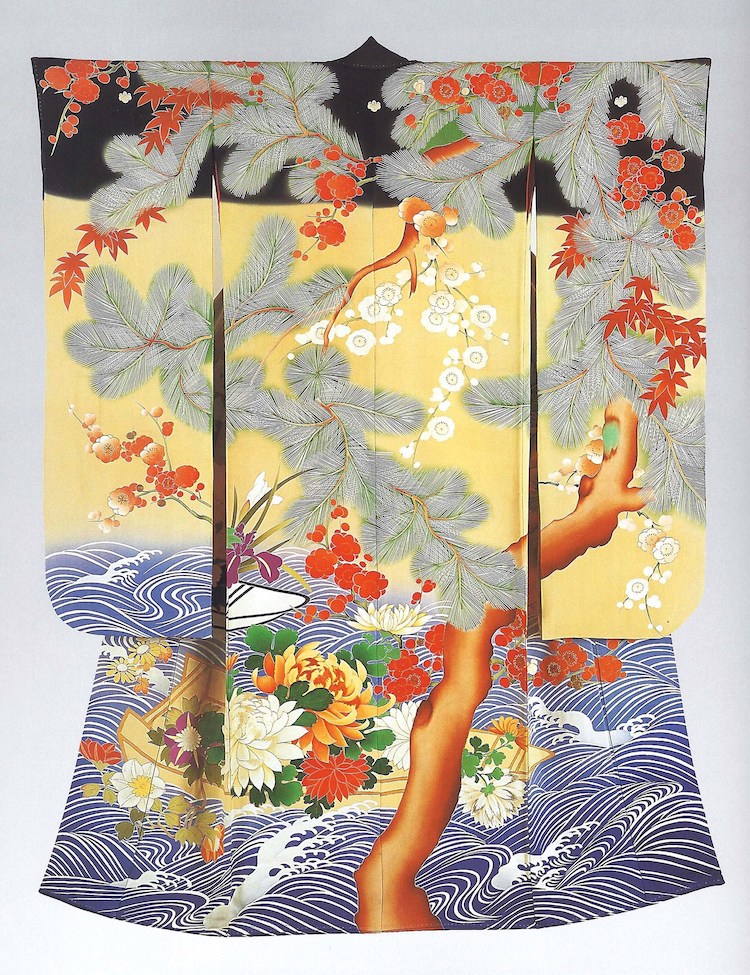
Kimono for a young woman, c. 1912–1926 (Photo: Khalili Collections via Wikimedia Commons, CC BY-SA 4.0)
Patterns, symbols, and other designs also help communicate the wearer’s status, personality traits, and virtues. Similar to woodblock prints, popular motifs include nature-inspired elements, like leaves, blossoms, and birds (namely, cranes).
Color
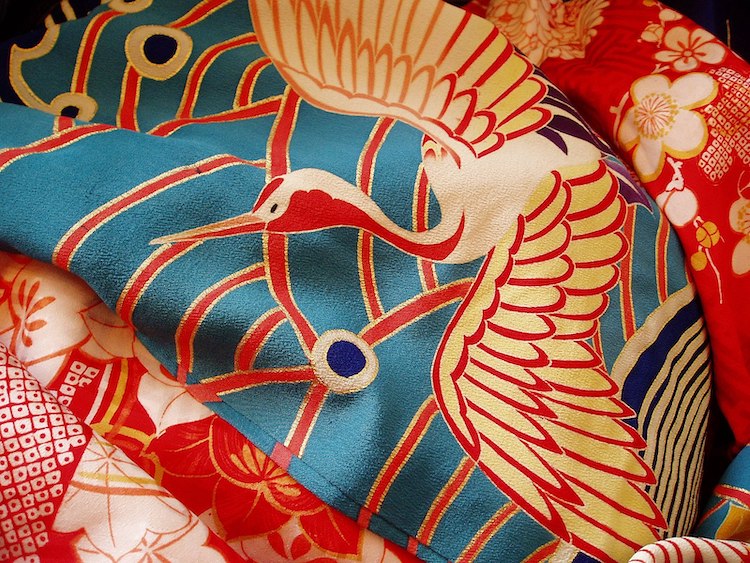
Kimono fabrics (Photo: merec0 via Wikimedia Commons, CC BY-SA 2.0)
On top of their imagery, kimonos’ colors also hold symbolic significance. Additionally, the pigments used to achieve certain colors are also representative. “Dyes are seen to embody the spirit of the plants from which they are extracted,” the Victoria & Albert Museum explains, “Any medicinal property is also believed to be transferred to the coloured cloth. Blue, for example, derives from indigo (ai), which is used to treat bites and stings, so wearing blue fabric is thought to serve as a repellent to snakes and insects.”
Material
Kimonos are made from various handmade and hand-decorated fabrics. Traditionally, these include linen, silk, and hemp. Today, materials like rayon, cotton, and polyester are often used. Unsurprisingly, however, the traditional, non-synthetic fabrics are favored.
History and Evolution
During the Heian period (794-1192 AD), an early, easy-to-wear prototype of the kimono emerged in Japan. Like the current-day kimono, this garment was composed of straight cuts of fabric and was intended to suit all body sizes and types.
Eventually, during the Edo period (1603-1868), this robe became known as a kosode—a term that literally translates to “small sleeves”—as its armholes decreased in size. The kosode played a particularly important role in this period, as all Japanese people (despite social status, age, or gender) wore it. Thus, in order to express their individuality and “describe” themselves, wearers adopted ways to customize their kosodes.
During the Meiji period (1868-1912), the kosode evolved into the kimono. Unlike its earlier edition, the kimono was worn predominantly by women. Still, in spite of these small changes, the garment’s main function—to visually communicate a message—remains unchanged even today.
Types of Kimonos
Yukata
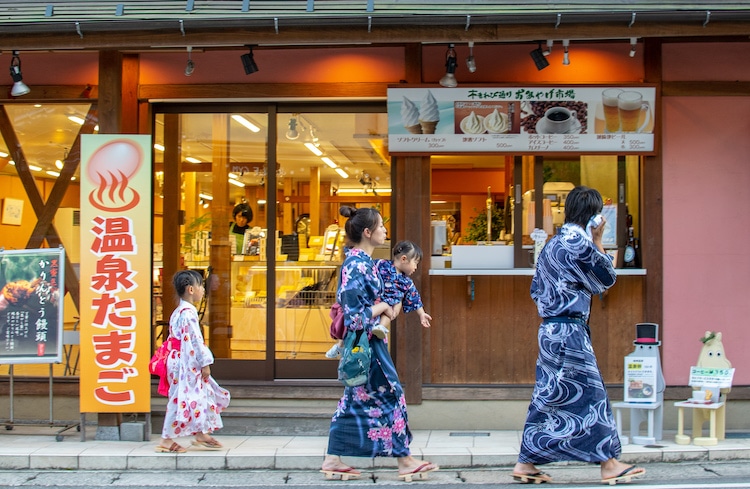
A family wearing yuakatas (Photo: Andy Atzert via Wikimedia Commons, CC BY-SA 2.0)
Yukatas are a casual, cotton kimono commonly worn during the summer and summer events (like festivals). Modern kimonos are designed to be easy to maintain and are machine-washable.
Iromuji
While most kimonos are adorned with motifs, some are left intentionally minimalist. Iromuji is a type of kimono worn to tea ceremonies and usually features no painted design. Its simple monochromatic appearance is supposed to not detract from the ceremony. Sometimes patterns are sewn into the garment.
Uchikake
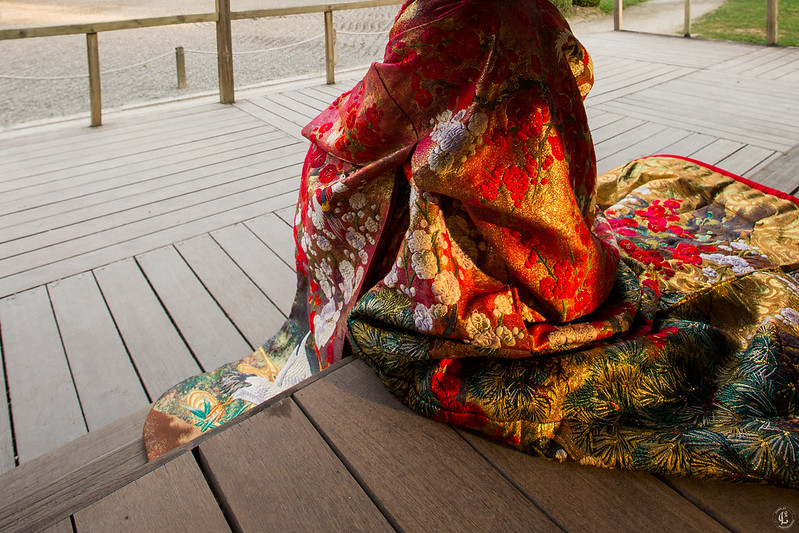 Uchikake is a formal type of kimono that was originally worn by samurai women in the 16th century. Centuries later, this garment was adopted into bridal wear. Since it is intended to be worn over another garment, like an overcoat, it is worn without an obi, and ornately decorated.
Uchikake is a formal type of kimono that was originally worn by samurai women in the 16th century. Centuries later, this garment was adopted into bridal wear. Since it is intended to be worn over another garment, like an overcoat, it is worn without an obi, and ornately decorated.
Shiromuku
Another bridal kimono is the shiromuki. An all-white garment, it is intended to be worn by brides in a traditional Japanese Shinto wedding ceremony. It is often paired with matching accessories.
The Contemporary Kimono

A unique contemporary kimono by Maya Caulfield to celebrate her Scottish and Japanese ancestry (Photo courtesy of Maya Caulfield)
Today, designers and artists have reinterpreted the traditional kimono in a myriad of ways. From upcycled wedding dresses to woven glass sculptures, these innovative creatives have come up with one-of-a-kind ways to both preserve Japanese heritage and showcase the beauty of the kimono.
Frequently Asked Questions
What is a kimono?
A kimono is a traditional Japanese garment. It is typically hand-sewn into a “T” shape from four single pieces of fabric called tans and tied with an obi, or belt.
What does a kimono symbolize?
A kimono is typically a symbol of longevity and good fortune, but it also depends on the style, motif, color, and material to reveal the individual identity of the wearer.
What is difference between a kimono and a yukata?
A kimono typically has a hand-sewn inner lining and a yukata never does. A yukata is made of a single layer of fabric and intended to be worn during warmer temperatures, especially at summer festivals.
This article has been edited and updated.
Related Articles:
Brides in Japan are Turning Their Long-Sleeve Kimonos Into Stunning Wedding Dresses
20+ Traditional Wedding Outfits from Around the World
Japanese Street Photography Highlights the Nation’s Rich Culture



